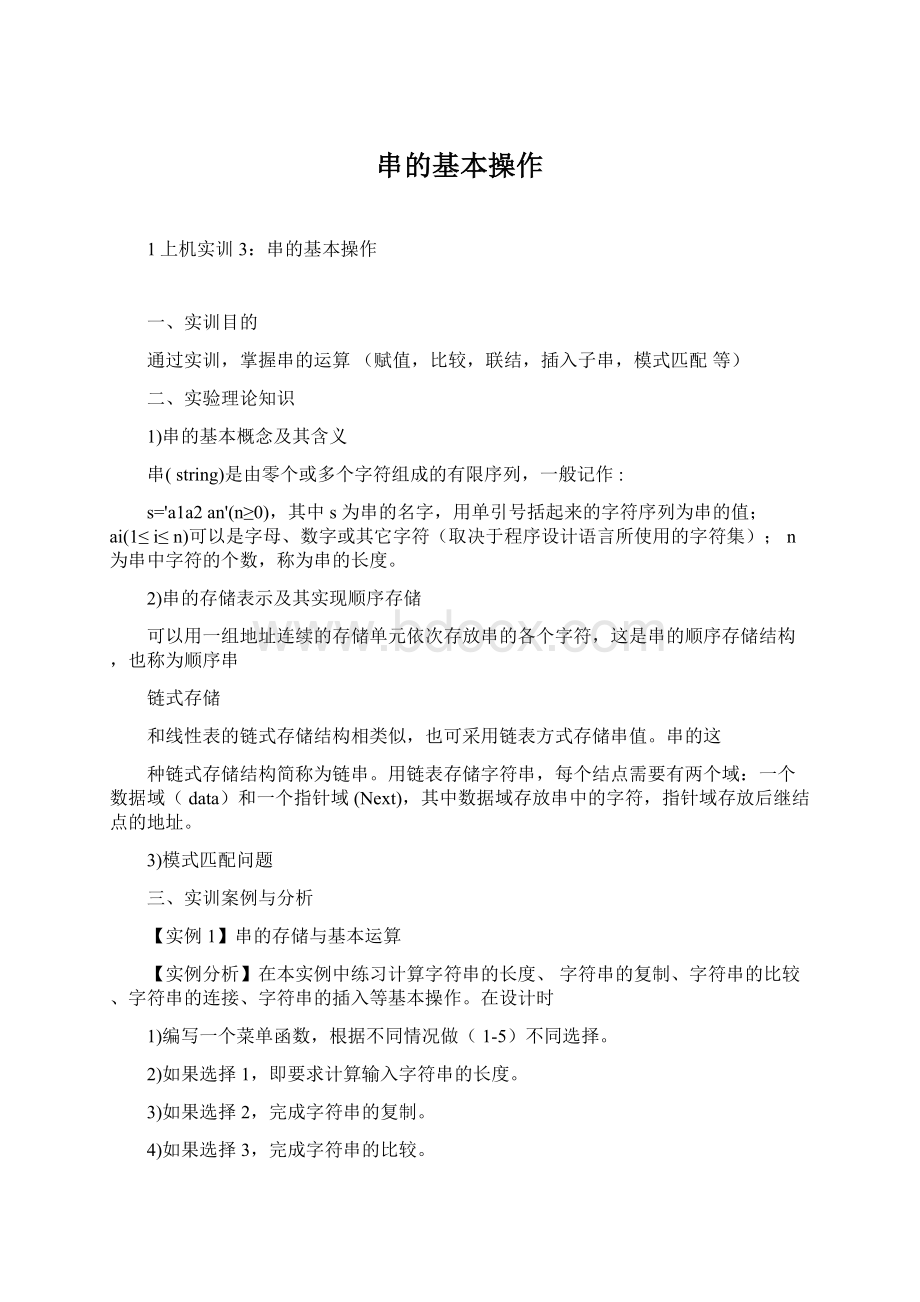串的基本操作.docx
《串的基本操作.docx》由会员分享,可在线阅读,更多相关《串的基本操作.docx(12页珍藏版)》请在冰豆网上搜索。

串的基本操作
1上机实训3:
串的基本操作
一、实训目的
通过实训,掌握串的运算(赋值,比较,联结,插入子串,模式匹配等)
二、实验理论知识
1)串的基本概念及其含义
串(string)是由零个或多个字符组成的有限序列,一般记作:
s='a1a2an'(n≥0),其中s为串的名字,用单引号括起来的字符序列为串的值;ai(1≤i≤n)可以是字母、数字或其它字符(取决于程序设计语言所使用的字符集);n为串中字符的个数,称为串的长度。
2)串的存储表示及其实现顺序存储
可以用一组地址连续的存储单元依次存放串的各个字符,这是串的顺序存储结构,也称为顺序串
链式存储
和线性表的链式存储结构相类似,也可采用链表方式存储串值。
串的这
种链式存储结构简称为链串。
用链表存储字符串,每个结点需要有两个域:
一个数据域(data)和一个指针域(Next),其中数据域存放串中的字符,指针域存放后继结点的地址。
3)模式匹配问题
三、实训案例与分析
【实例1】串的存储与基本运算
【实例分析】在本实例中练习计算字符串的长度、字符串的复制、字符串的比较、字符串的连接、字符串的插入等基本操作。
在设计时
1)编写一个菜单函数,根据不同情况做(1-5)不同选择。
2)如果选择1,即要求计算输入字符串的长度。
3)如果选择2,完成字符串的复制。
4)如果选择3,完成字符串的比较。
5)如果选择4,完成两个字符串的连接。
6)如果选择5,字符串的插入。
【参考程序】
#include
#defineMAX128
typedefenum{fail,success}status;
typedefenum{false,true}boolean;
main()
{intstrlen();voidstrass();booleanstrcmp();statusstrcat();
statusstrins();
intt,n,i;
booleanb;
statusst;
chars[MAX],s1[MAX],s2[MAX];
printf("\n1.Thelengthofstring\n");
printf("2.Theassignmentofstring\n");
printf("3.Astringcomparewithanotherstring:
\n");printf("4.Astringconnectwithanotherstring:
\n");printf("5.Astringtobeinsertedintoanotherstring\n");printf("Pleaseinputaoperation:
");/*输入操作选项*/scanf("%d",&t);
switch(t)
{
case1:
printf("pleaseinputastring:
\n");
getchar();
gets(s);
n=strlen(s);
printf("thelengthis:
%d",n);
break;
case2:
printf("pleaseinputthefirststring:
\n");
getchar();
gets(s1);
printf("pleaseinputthesecondstring:
\n");
getchar();
gets(s2);
strass(s1,s2);
break;
case3:
printf("pleaseinputthefirststring:
\n");
getchar();
gets(s1);
printf("pleaseinputthesecondstring:
\n");
gets(s2);
b=strcmp(s1,s2);
if(b==true)
printf("equal\n");
else
printf("notequal\n");
break;
case4:
printf("pleaseinputthefirststring:
\n");
getchar();
gets(s1);
printf("pleaseinputthesecondstring:
\n");
gets(s2);
st=strcat(s1,s2);
if(st==success)
printf("answeris%s\n",s1);
else
printf("error!
\n");
break;
case5:
printf("pleaseinputthefirststring:
\n");
getchar();
gets(s1);
printf("pleaseinputthesecondstring:
\n");
gets(s2);
printf("pleaseinputi:
");
scanf("%d",&i);
st=strins(s1,i,s2);
if(st==success)
printf("answeris:
%s\n",s1);
elseprintf("error!
\n");
break;
case0:
break;
default:
printf("Thereisn'tthisoperation!
");
}
}
intstrlen(s)/*求字符串的长度子函数*/
chars[];
{inti;for(i=0;s[i]!
='\0';i++);return(i);
}
voidstrass(s1,s2)chars1[],s2[];
{inti=0;while(s1[i]!
='\0'){s2[i]=s1[i];
i++;
}
s2[i]='\0';
printf("s2is%s",s2);
}
booleanstrcmp(s1,s2)/*字符串比较子函数*/
chars1[],s2[];
{inti=0;
while(s1[i]==s2[i]&&s1[i]!
='\0'&&s2[i]!
='\0')
i++;
if(s1[i]=='\0'&&s2[i]=='\0')
return(true);
else
return(false);
}
statusstrcat(s1,s2)/*字符串连接子函数*/
chars1[],s2[];
{inti,j,k;i=strlen(s1);j=strlen(s2);if((i+j)>=MAXN)return(fail);for(k=0;k<=j;k++)
s1[i+k]=s2[k];
return(success);
}
statusstrins(s1,i,s2)
chars1[],s2[];
inti;
{intm,n,k;m=strlen(s1);n=strlen(s2);
if(i<0||i>m||(m+n)>MAXN)return(fail);for(k=m;k>=i;k--)s1[k+n]=s1[k];for(k=0;kreturn(success);
}
【测试数据与结果:
】
计算字符串的长度
1.Thelengthofstring
2.Theassignmentofstring
3.Astringcomparewithanotherstring:
4.Astringconnectwithanotherstring:
5.AstringtobeinsertedintoanotherstringPleaseinputaopertation:
1
pleaseinputastring:
youareaboy!
thelengthis:
14
字符串的复制
1.Thelengthofstring
2.Theassignmentofstring
3.Astringcomparewithanotherstring:
4.Astringconnectwithanotherstring:
5.AstringtobeinsertedintoanotherstringPleaseinputaopertation:
2
pleaseinputthefirststring:
youareaboy!
pleaseinputthesecondstring:
iamagirl!
s2isyouareaboy!
字符串的比较
1.Thelengthofstring
2.Theassignmentofstring
3.Astringcomparewithanotherstring:
4.Astringconnectwithanotherstring:
5.Astringtobeinsertedintoanotherstring
Pleaseinputaopertation:
3
pleaseinputthefirststring:
youareaboy!
pleaseinputthesecondstring:
iamagirl!
notequal
字符串的连接
1.Thelengthofstring
2.Theassignmentofstring
3.Astringcomparewithanotherstring:
4.Astringconnectwithanotherstring:
5.AstringtobeinsertedintoanotherstringPleaseinputaopertation:
4
pleaseinputthefirststring:
youareaboy!
pleaseinputthesecondstring:
iamagirl!
answeris:
youareaboy!
iamagirl!
字符串的插入
1.Thelengthofstring
2.Theassignmentofstring
3.Astringcomparewithanotherstring:
4.Astringconnectwithanotherstring:
5.AstringtobeinsertedintoanotherstringPleaseinputaopertation:
5
pleaseinputthefirststring:
youareaboy!
pleaseinputthesecondstring:
iamagirl!
pleaseinputi:
2
answerisiamagirl!
youareaboy!
【实例2】统计主串指定单词在主串中出现的次数和位置
【实例描述】统计主串指定单词在主串中出现的次数和位置,要求:
1)输入以回车作为结束符的一串字符作为主串;
2)求主串中指定单词出现的次数和位置,注意单词与子串的区别;【实例分析】
假设num存放出现次数,初始化为0,position[i]存放每一次匹配时的位置。
1)编写一个菜单函数,根据不同情况做(0-3)不同选择
2)如果选择1,即要求匹配的是单个字符c,让i=0,依次比较主串的第i
个字符,如果s[i]==c,则匹配成功,position[num]=i;num++;
3)如果选择2,即要求匹配的是子串t,则此算法即为模式匹配算法,与模
式匹配不同的是每次匹配成功时不是返回,而是设置position和num的值,position[num]=i-j;num++;
4)如果选择
3,即要求匹配的是单词
t,假设主串中单词之间用空格分割,
此算法与3)的不同,与t匹配的子串必须是一个单词,因此首先要找出主串中的单词,然后让t与找到的单词比较,若结果相等,则匹配成功,设置position和num的值,position[num]=i-j;num++;否则,查找主串中的下一个单词,直到主串结束。
【实例实现】
#include"string.h"
#include"stdio.h"
charstr[60];
voidmenu()/*菜单选择函数*/
{charchoice,c;
chart[20];
printf("指定类型\n");
printf("====================\n");
printf("1.单个字符\n");
printf("2.指定子串\n");
printf("3.指定单词\n");
printf("0.退出\n");
printf("====================\n");
do
{
printf("请你在上述功能中选择(0-3):
");
choice=getchar();
getchar();
switch(choice)
{case'1':
printf("inputchar:
");/*指定单个字符匹配的情况*/c=getchar();getchar();
index_char(str,c);
break;
case'2':
printf("inputstring:
");/*指定子串匹配的情况*/gets(t);
index_string(str,t);break;
case'3':
printf("inputword:
");/*指定单词匹配的情况*/gets(t);
index_word(str,t);break;
case'0':
return;
}
}while
(1);
}
index_string(char*s,char*t)/*子串匹配函数*/
{inti,j,num=0,position[80];
/*num存放匹配个数,position中存放每一次匹配的位置*/i=0;j=0;
while(s[i]!
='\0')/*主串没有结束*/
{while(s[i]!
='\0'&&t[j]!
='\0')/*没有遇到结束符*/
if(s[i]==t[j])/*继续*/
{i++;
j++;}
else/*回溯*/
{i=i-j+1;
j=0;
}
if(t[j]=='\0')
{position[num]=i-j;num++;j=0;}/*匹配成功,存放位置,并且次数加1*/
}
if(num)/*如果匹配成功,输出匹配次数和位置*/
{printf("\nthenumberofstring\"%s\"is%d",t,num);
printf("\nthepositionis:
");
for(i=0;iprintf("%5d",position[i]);
printf("\n");}
else
printf("\nthestringisnotfound!
",i);
}
index_word(char*s,char*t)
{inti,j,num=0,position[80];
charword[20];
i=j=0;
while(s[i]!
='\0')
{j=0;
while(s[i]=='')
i++;
while((s[i]!
='')&&(s[i]!
='\0'))/*寻找主串中的单词*/
word[j++]=str[i++];
word[j]='\0';
if(strcmp(t,word)==0)/*如果输入的单词与主串中的单词匹配*/{position[num]=i-j;num++;}
}
if(num)/*如果匹配成功,输出匹配次数和位置*/
{
printf("\nthenumberofword\"%s\"is%d",t,num);
printf("\nthepositionis:
");
for(i=0;iprintf("%5d",position[i]);
printf("\n");
}
else
printf("\nthewordisnotfound!
");
}
index_char(char*s,chart)
{
inti=0,num=0,position[80];
while(s[i]!
='\0')
{if(s[i]==t){position[num]=i;num++;}
i++;}
if(num)
{
printf("\nthenumberofchar'%c'is%d",t,num);
printf("\nthepositionis:
");
for(i=0;iprintf("%5d",position[i]);
printf("\n");
}
else
printf("\nthecharisnotfound!
");
}
main()
{printf("\ninputthestring1:
");
gets(str);
menu();
}
【测试数据与结果】
inputthestring1:
aabbbcccdddeabcde
指定类型
====================
1.单个字符
2.指定子串
3.指定单词
0.退出
====================
请你在上述功能中选择(0-3):
1
inputchar:
a
thenumberofchar'a'is3
thepositionis:
0116
请你在上述功能中选择(0-3):
2
inputstring:
ab
thenumberofstring"ab"is2
thepositionis:
116
请你在上述功能中选择(0-3):
3
inputword:
ccd
thenumberofword"ccd"is1
thepositionis:
8
请你在上述功能中选择(0-3):
0
四、思考项目
1)计算一个子串在一个字符串中出现的次数。
2)统计文本文件中给定的单词数。